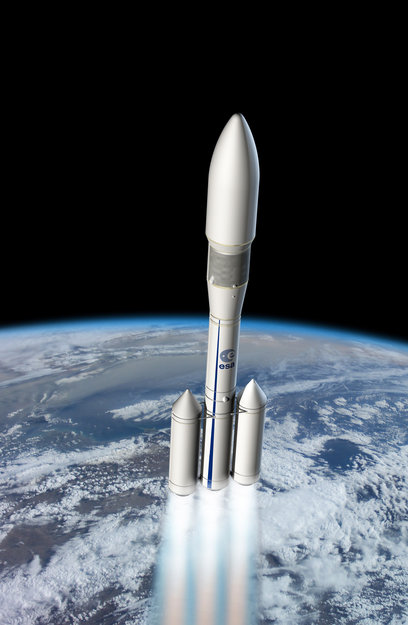This article is more than 1 year old
European Space Agency goes for mostly solid Ariane 6
Forget manned, forget deep space. Show us the money
The European Space Agency has announced its selection for the rocket design which will replace the mighty Ariane 5 as Europe's workhorse launch system.

OK, forget power and people. You want cheap? Here it is.
The planned new Ariane 6, which will fly in the early 2020s, is to employ an unusual arrangement of engines and technologies. Its first stage will consist of triple solid-fuelled rockets arranged in a line: to date in space launch, it has been much more normal to use liquid-fuelled first stages, perhaps with extra solid fuelled rockets strapped on (as with the Space Shuttle, the current Ariane 5 and the upcoming NASA shuttle-retread Space Launch System).
The Ariane 6 second stage will consist of another solid rocket, and then the third and final stage will be cryogenically liquid-fuelled, using a Vinci rocket engine running on liquid hydrogen and oxygen. As solid rockets cannot be throttled or turned on and off once lit, it is this third stage which will furnish the controllability needed to insert satellites into orbit.
The ESA calculates that the Ariane 6 will be able to place 3-6 tonnes into Geosynchronous Transfer Orbit, the main money-making destination to which communications satellites are generally lifted.
The current Ariane 5 is planned to reach a geostationary delivery capacity of 11.5 tonnes this decade, once the adapted Ariane 5 ME version comes into service around 2018: this can only be fully exploited by using each launch to carry two or three satellites of typical commercial size, which complicates operations.
Liquid hydrogen fuelled first stages like that of the Ariane 5 are powerful, but they are costly and troublesome to prepare. They are nowadays generally seen as an option more suitable to government operations where a lot of performance is wanted and quick launch and cost are not the primary issues: for instance in launching hefty top-secret US spy satellites aboard Delta IV Heavies, or weighty manned missions atop Shuttles and - in coming years - the NASA Space Launch System.
In this context it's worth noting that the current Ariane 5 was originally meant to carry a manned European mini-shuttle, the Hermes, though in fact this never happened.
For workaday tasks, many have turned to kerosene-fuelled rockets like the Atlas V (though this has a hydrogen upper stage) and the SpaceX Falcon 9. These are cheaper and less fiddly to use than hydrogen jobs, but retain the desirable controllability of liquid fuel: as seen recently when a Falcon 9 successfully aborted takeoff after main engine ignition and then later, having been checked out and refuelled, took off without trouble. A solid fuelled rocket would be likely to destroy itself in a similar situation if the problem was at all serious.
Despite all this, NASA has long used solid boosters for manned missions on the Space Shuttle, and had planned in recent years to send up its post-Shuttle 'nauts atop an all-solid first stage on the planned Ares I: and ballistic missiles have long been all-solid for reasons of storage and quick launch.
In any case, the new mostly-solid Ariane 6 is about cost cutting and competing in the geosynch commercial market: the cash strapped ESA nations have long since abandoned lofty manned-flight and deep space goals, and this is reflected in the new plan. Whether solid is genuinely a better idea than kerosene remains to be seen.
It also remains to be seen whether the unwieldy multinational French-led rocket project, likely to be plagued by political workshare issues, can really manage to beat new boy Elon Musk and his kerosene-powered rockets on any suit at all.
Musk and his SpaceX Falcons remain focused on manned flight, heavy lift, perhaps one day superheavy lift deep space - and still look likely to beat any government outfit you care to name on cost.
None of which, given the nature of the world's "commercial" and governmental space markets, means that Musk will necessarily get any custom.
It's still looking like an interesting decade ahead on the rocket beat. ®
